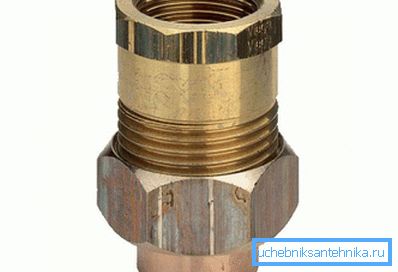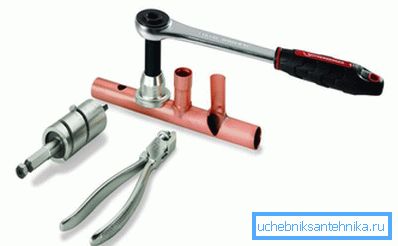How to connect copper pipes
Despite the development of technologies and the popularity of the use of polymers, metal is successfully used in the manufacture of pipelines for water supply and heating systems. Steel, brass and copper are commonly used for these purposes. The latter has excellent corrosion resistance, mechanical strength and resistance to high temperatures and pressures. Therefore, despite some high cost of this material, its use is fully justified.
Before connecting copper pipes, it is necessary to decide whether to do this with or without soldering.
Solder connection

One of the first options is to consider connecting the pipes by soldering. It should be immediately noted that there are two ways of soldering copper pipes - this is a low-temperature and high-temperature method. As it is easy to guess, the difference between them lies in the temperature at which soldering occurs. At low temperature conditions, elements are heated to 300 ° C and solders with a low melting point are used. High-temperature soldering is used for installation of systems that are experiencing significant loads, for example, in industry, the use of this technique for private purposes is impractical.

When connecting copper pipes by soldering, as a rule, connecting elements are used, called fittings, tin-based solders and fluxes. The process of connecting pipes is as follows.
- First you need to cut the pipes of the desired size. In this case, it is necessary to take care and be sure to consider the size of the fitting itself.
- The ends of the pipes to be connected must be carefully inspected for the presence of various defects such as cracks, chips or burrs. Their presence is unacceptable, as it can affect the tightness of the connection, therefore in case of detection all defects must be eliminated.
- If the ends of the pipes in order, then you can proceed to the connection. It should be noted that there are several connection options, for example, you need to connect more than two pipes or pipes of different diameters, therefore fittings should be selected that match the purpose.
- The end of the pipe and the inner part of the connecting element is processed using a flux - a special compound that acts as a degreaser, preparing the surface for a stronger connection.
- After that, the end of the pipe is inserted into the fitting and heated. The fitting is selected so that its diameter is 1–1.5 mm larger than the diameter of the pipe. The pipes are heated with a gas burner. The space between the connected elements is filled with melting solder. The modern market offers a variety of ready-to-use ready-made solders, so there should be no problems with this.
- After the solder is evenly distributed around the entire circumference, the parts to be joined should be left until the solder completely solidifies, forming a solid connection.
- The final step should be to check the connection, that is, the water must be started up. Thus, there will be not only a check, but also the removal of flux residues that may remain on the inner surface of the pipes, which is undesirable because it can cause corrosion.
Solderless connection
It should also be noted that, despite the fact that connecting copper pipes by soldering is the most reliable and expedient in most cases, there are times when soldering is not possible and in such cases you can resort to joining without soldering using special fittings. The principle of their operation is based on the clamping effect resulting from the thread connection. The process of connection is as follows.
- First, the fitting, usually consisting of two parts, must be disassembled.
- One of the parts is put on the pipe. More specifically, a nut and a clamping ring are put on.
- After that, the pipe is inserted into the connecting fitting, and the nut is tightened along the thread.

As a rule, a fitting is attached to such fittings, in strict accordance with which all work must be carried out.
Tip! The connection of pipes in this way is not sufficiently reliable, so even the slightest distortions in the connection, as well as violation of technology, are unacceptable. In order to achieve greater tightness of the threaded connection, it can be sealed with special threads, and it is unacceptable that the excess should get inside the pipe, as this can impede the free passage of water.
Whichever method of connection is chosen, the work should be carried out, following a number of general rules:
- For the connection must be used pipes from the same metal. If you need to connect the copper pipe with any other, you need to choose the appropriate method. For example, soldering is not suitable for connecting copper and PVC pipes.
- If it is supposed to connect copper and steel pipes, then steel need to be placed in front of copper.
- Be careful when tightening threaded connections, especially if thin-walled pipes are used.
- In order not to be mistaken with the amount of solder, the length of the wire should be taken equal to the circumference of the pipe.
- For heating pipes, it is best to use a special burner. The use of a conventional blowtorch is permissible in principle, but there is a risk of overheating the junction, which will complicate the work.
- Copper pipes are somewhat costly from the material point of view, therefore before starting work it is advisable to carry out preliminary calculations of the amount of material. It should not be forgotten that the connecting elements also have certain dimensions, which must also be taken into account.

In conclusion, it should be said that the connection of copper pipes is not very complicated from a technological point of view, but for the first time there may be some difficulties. In order to have the most complete picture of the process, you can consult with professionals or at least watch a video on this topic.
Video
This video shows the process of brazing copper pipes.